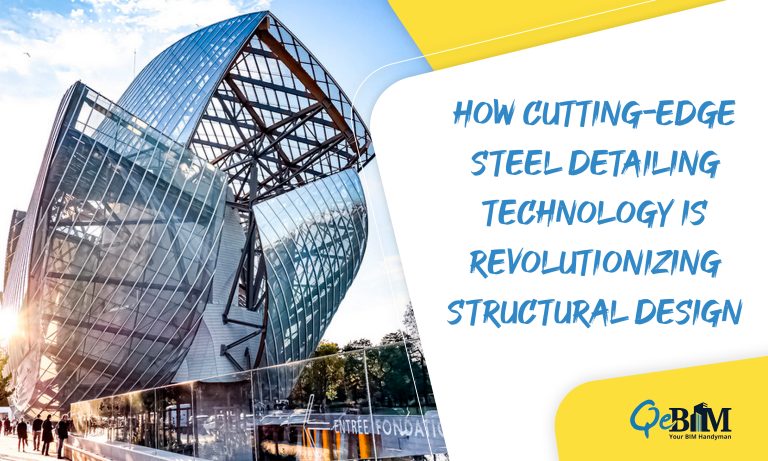How Cutting-Edge Steel Detailing Technology is Revolutionizing Structural Design

Introduction
Modern technology has been crucial in modifying conventional building techniques in the fields of engineering and architecture. Structural design is one such sector that has made tremendous strides, notably in the domain of steel details. The way we conceptualize, plan, and construct buildings has been completely transformed by the combination of Structural BIM Services as well as steel detailing services. This blog will examine the implications of this innovative technology and the benefits it offers to the building sector.
The Rise of Structural BIM Services
Building information modeling (BIM) is a digital depiction of a building’s structural and functional elements that promotes communication and effective workflows during the construction phase. BIM integration in structural design offers several benefits, including increased stakeholder communication, reduced error rates, and enhanced visualization.
Architects, engineers, and construction specialists may collaborate on the same platform using structural BIM services, which streamlines the design and documentation process. Superior visualization made possible by the 3D modeling abilities of BIM enables stakeholders to arrive at knowledgeable decisions early in the project life cycle, eventually resulting in improved accuracy and successful construction.
Transforming Steel Detailing Services
The procedure of creating comprehensive plans and drawings that direct the manufacturing and installation of steel components is known as “steel detailing,” and it is an essential step in the building process. This procedure had been formerly manual, laborious, and notorious for mistakes. But with the arrival of cutting-edge software and technology, Steel Detailing Services are undergoing a radical change. Historically, 2D drawings have been used for steel detailing. Nevertheless, there seems to have an increasing tendency in recent years to use BIM (Building Information Modelling) software and 3D modeling for steel details.
Today’s computer-aided design (CAD) software for steel detailing enables engineers to produce accurate and comprehensive drawings. With the use of these advanced tools, fabrication drawings may be automatically generated, bill of materials (BOM) accuracy can be ensured, and the design as well as fabrication teams.
The Integration of BIM and Steel Detailing
In the construction business, the combination of BIM and Steel Detailing Services has changed the game. Engineers may optimize steel structures to achieve improved productivity and financial productivity by integrating the 3D modeling capabilities of BIM with the precision of steel detailing software. According to the Steel Detailing Institute, the use of 3D modelling tools in steel detailing could decrease drawing preparation time by up to 40%.
The absence of disputes during the design process serves as one of the main benefits of this connection. Possible conflicts between structural components, mechanical systems, and architectural aspects may be found and handled early on thanks to the availability of all design and details information on a single platform, reducing the need for expensive adjustments during construction.
Advantages of Revolutionizing Structural Design
- Improved Collaboration: By fostering improved interaction and ensuring that everyone appears to be on the same page, BIM and Steel Detailing Services help reduce confusion and mistakes amongst diverse stakeholders.
- Accelerated Project Delivery: The design and construction phases of the project are completed more quickly thanks to modern technologies. The time that is preserved during the design and detailing stage may be devoted to other crucial project components.
- Cost Reductions: By removing conflicts and inconsistencies early on in the project’s life cycle, construction revisions, and bottlenecks are reduced, which results in significant cost savings.
- Sustainability: Structural BIM Services enable engineers to simulate several design scenarios in order to optimize the framework for optimal sustainability and efficient use of energy.
- Greater Security: Safer building practices are made possible by comprehensive and exact detailing, which lowers the possibility of construction mistakes. Detailing may be done more accurately and precisely thanks to 3D modeling and BIM software. This is possible because the program can account for all of the intricate relationships between a steel structure’s many parts.
- Fewer mistakes and inconsistencies: Using BIM and 3D modeling software might assist to lessen mistakes and missed opportunities throughout the detailed phase. This is due to the software’s ability to look for conflicts and anomalies autonomously.
- Shorter turnaround times: Steel detailing may be completed more quickly with the use of 3D modelling and BIM software. This is due to the software’s ability to automate several operations that might have required manual labor.
Conclusion
The landscape of structural design in the building business has been completely changed by the combination of structural BIM services as well as steel detailing technology. This cutting-edge technology stands at the vanguard of contemporary building practices because of its effective 3D modeling, precise detailing, improved cooperation, and considerable cost reductions. We may anticipate even more ground-breaking advancements in structural design as technology progresses, further advancing the sector toward a more effective and environmentally friendly future.